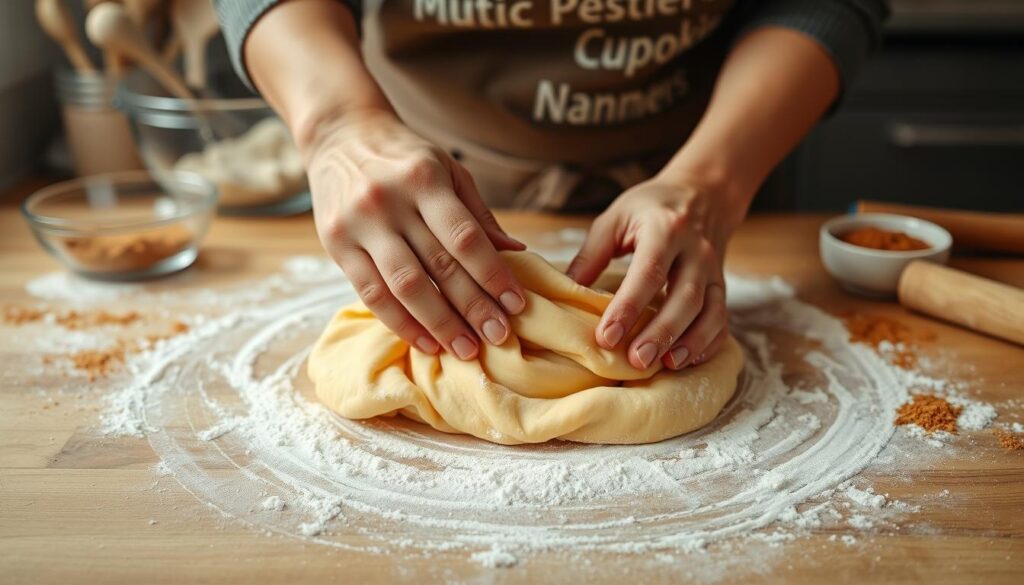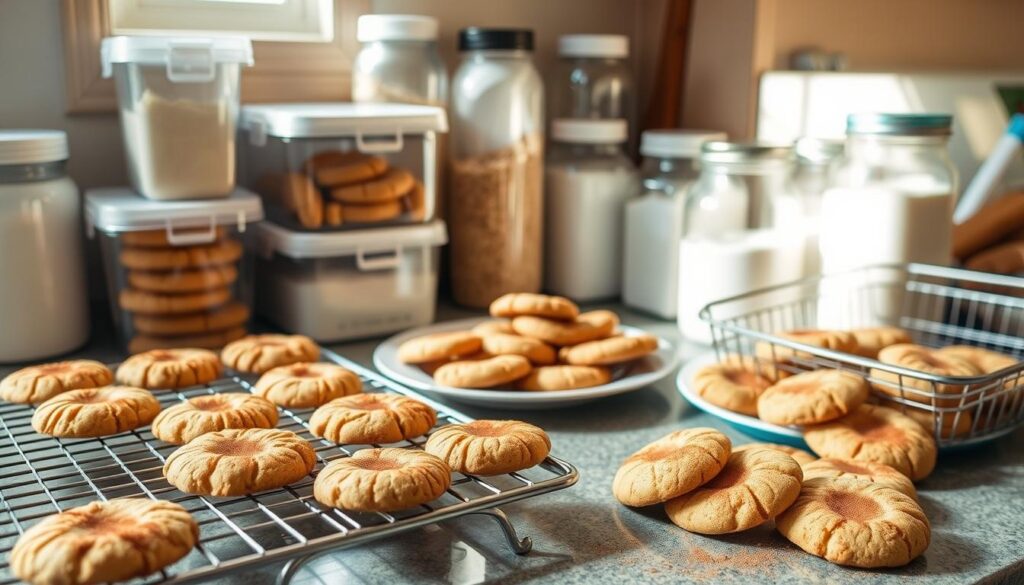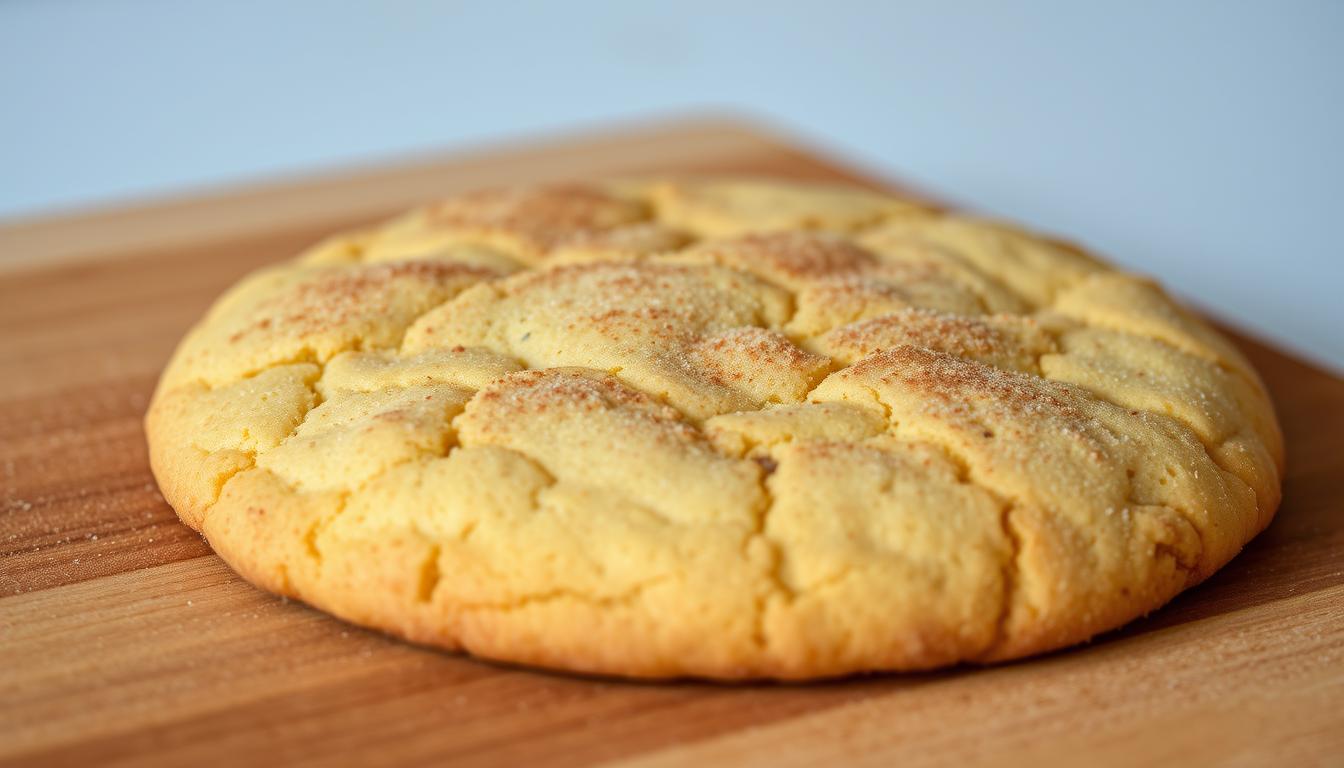For over three decades, this beloved family favorite has earned rave reviews for its perfect balance of soft, chewy texture and warm cinnamon flavor. No chilling required, making it ideal for spontaneous baking sessions or last-minute gatherings.
The secret lies in a double coating of cinnamon sugar and the subtle tang from cream of tartar. With just nine pantry staples, you can recreate this nostalgic treat that disappears quickly at every potluck or holiday party.
Generations of home bakers have perfected these golden delights, passing down pro tips for consistent results. Whether you’re introducing kids to baking or craving childhood comfort food, this version delivers every time.
Key Takeaways
- 30-year tested family recipe with consistent 5-star results
- Features signature soft texture with double cinnamon-sugar coating
- Requires only 9 common ingredients and no dough chilling
- Perfect for holiday baking or kid-friendly kitchen projects
- Includes professional tips from decades of recipe refinement
Why This Snickerdoodle Cookie Recipe Works
What makes these treats stand out is the perfect blend of science and simplicity. Two elements—cream of tartar and a double-coating technique—create the iconic taste and look.
The Magic of Cream of Tartar
Cream of tartar isn’t just for stabilizing egg whites. Here, it plays three roles: a leavening agent, flavor enhancer, and texture creator. When mixed with baking soda, it triggers a chemical reaction that lifts the dough and creates a crinkly surface.
Without it, the dough loses its subtle tang and airy texture. Testing confirms this tiny ingredient is non-negotiable for authentic results.
Double Cinnamon-Sugar Coating
Rolling the dough twice in cinnamon sugar ensures no bare spots. A 2:1 cinnamon-to-sugar ratio gives bold flavor without clumping. Properly coated dough should have no visible patches—just even, sparkly goodness.
Skip the double roll, and you’ll miss the signature crunch and caramelized edges. For best results, coat balls once before baking and again lightly after they’re done.
Key Ingredients for Perfect Snickerdoodles
Every ingredient plays a critical role in achieving the perfect texture and flavor. From butter temperature to cinnamon quality, minor adjustments impact your final product. Here’s how to choose wisely.
Unsalted Butter vs. Salted Butter
Unsalted butter (65–67°F) gives precise control over salt content. Salted versions require recipe adjustments—reduce added salt by ¼ teaspoon per stick. The fat content (80–82%) affects spread: higher fat creates thinner, crispier edges.
| Butter Type | Best For | Adjustment Needed |
|---|---|---|
| Unsalted | Controlled flavor | None |
| Salted | Convenience | Reduce added salt |
Why Cream of Tartar Is Non-Negotiable
Cream tartar reacts with baking soda to lift dough and create a tangy taste. Substitutes like 1 tsp baking powder + ½ tsp vinegar work but alter texture slightly. For authentic results, stick to the original.
The Best Cinnamon for Maximum Flavor
Saigon cinnamon (bold, sweet) outperforms Cassia (spicy, harsh). Store it in airtight containers away from light to preserve potency. A 2:1 sugar-to-cinnamon ratio ensures even coating without clumps.
Measure flour using the spoon-and-level method for accuracy. Brands like King Arthur Flour offer consistent protein levels, crucial for chewiness. These small choices guarantee bakery-quality results every time.
Step-by-Step Snickerdoodle Instructions
Mastering the basics of dough preparation ensures bakery-quality results every time. Follow these techniques to achieve the ideal texture and flavor balance.

How to Cream Butter and Sugar Perfectly
Start with softened butter (65–67°F) and granulated sugar. Beat for 4–5 minutes until pale yellow and fluffy. Scrape the bowl every 2 minutes for even mixing.
Properly creamed ingredients should hold peaks when lifted. Cold butter won’t incorporate fully, while melted butter creates greasy dough.
Mixing Dry Ingredients Without Overworking
Whisk dry ingredients separately, then fold into wet mix in 3 batches. Use 12–15 gentle strokes—just until no flour streaks remain. Overmixing develops gluten, leading to tough results.
Check consistency: The dough should be slightly sticky but hold shape when rolled. If too soft, chill for 10 minutes before portioning with a #40 scoop.
- Parchment vs. silicone: Parchment prevents spreading; silicone promotes even browning.
- Fix overmixed dough: Add 1 tbsp milk and knead lightly to soften.
Baking Tips for Soft & Chewy Cookies
Getting the perfect texture requires precision in temperature and timing. Small adjustments can mean the difference between soft-centered delights and overdone discs. Follow these tested methods for foolproof results.
Setting the Right Oven Conditions
Preheat to 350°F—the sweet spot for even baking. An oven thermometer ensures accuracy, as dials can be off by 25°F. Dark pans bake faster than light ones; reduce temperature by 25°F if using dark metal.
| Pan Type | Adjustment | Bake Time |
|---|---|---|
| Light-colored | None | 8–11 minutes |
| Dark-colored | Reduce heat by 25°F | 7–10 minutes |
Spotting the Perfect Doneness
Edges should be golden, while centers stay puffed and soft. They firm up during cooling due to carryover cooking. Use the thumb test: lightly press the center—it should spring back slightly but leave a faint indent.
- Altitude adjustment: Above 3,000 ft? Increase temperature by 15–25°F and shorten bake time.
- Rack position: Middle rack prevents uneven browning.
- Batch rotation: Rotate pans halfway for consistent results.
The Secret to the Cinnamon-Sugar Coating
The cinnamon sugar coating isn’t just for looks—it’s a game-changer for flavor and texture. A flawless finish requires precision, from sugar grain size to rolling timing. Here’s how to nail it.
Twice-Rolling for Even Coverage
Roll dough balls (40g each) in cinnamon sugar twice. First, coat them fully before baking. After a 5-minute rest, roll again lightly for extra crunch. Fine sugar sticks better than coarse varieties.
Why it works: The first layer caramelizes, while the second adds sparkle. Miss a step, and patches bake up bare.
- Weight vs. volume: A kitchen scale ensures uniform 40g portions for even baking.
- Coating station: Use shallow bowls for easy rolling. Tap off excess sugar gently.
- Humidity fix: Sticky dough? Dust hands with extra sugar to prevent clumping.
Store leftover sugar mix in a jar—it stays fresh for weeks. Under-coated? Dab melted butter and reroll warm treats.
How to Keep Snickerdoodles Fresh
Freshly baked treats deserve proper storage to maintain their irresistible texture. Whether you’re saving leftovers or prepping for future cravings, these methods ensure every bite stays soft and flavorful.

Room Temperature Storage Tips
Store at room temperature (68–72°F) in an airtight container for 3–4 days. Glass or stainless steel containers prevent moisture loss better than plastic. For extra softness, add a slice of bread to absorb excess humidity.
- Revive stale treats: Microwave for 5 seconds or warm in a 300°F oven for 2 minutes.
- Layer wisely: Use parchment paper between stacks to avoid sticking.
Freezing Dough vs. Baked Cookies
Unbaked dough freezes well for up to 3 months. Portion into balls, freeze on a tray, then transfer to freezer bags. For baked cookies, cool completely before sealing to prevent condensation.
| Method | Duration | Best For |
|---|---|---|
| Dough | 3 months | Fresh-baked taste anytime |
| Baked | 4 months | Quick thaw-and-serve |
Pro tip: Label bags with dates and use vacuum sealing to prevent ice crystals. Thaw frozen dough overnight in the fridge before baking.
Snickerdoodle Variations to Try
Elevate your baking game with creative twists on a classic favorite. These adaptations maintain the signature texture while introducing exciting new flavors. Whether you prefer mix-ins or stuffed centers, these recipes deliver delicious results every time.
Cinnamon Chip Upgrade
Ghirardelli’s chocolate chip alternatives add bursts of warm spice throughout each bite. Fold 1 cup of chips into the dough after mixing—the melty pockets pair perfectly with the cinnamon coating.
For balanced flavor, reduce the coating’s cinnamon by 25%. The chips provide enough spice on their own. Bake as usual, though some ovens may need an extra minute.
Gooey Caramel Surprise
Kraft caramels create molten centers when stuffed inside portioned dough. Wrap each square in a 40g ball, ensuring complete coverage to prevent leaks. Add 2 minutes to the bake time for proper melting.
Presentation tip: Dust finished treats with flaky sea salt. The contrast enhances both sweetness and richness. For easier handling, freeze caramels for 15 minutes before wrapping.
Dietary note: Use vegan caramels and plant-based butter for allergy-friendly versions. The texture remains nearly identical to traditional recipes.
Common Snickerdoodle Mistakes to Avoid
Even experienced bakers can stumble on simple pitfalls when making these treats. Two critical areas—baking time and ingredients measurement—often determine success or disappointment. Mastering these ensures your batch turns out perfectly every time.
Overbaking (and How to Fix It)
Golden edges should still have soft centers when removed from heat. Carryover cooking firms them perfectly during cooling. If they darken too much, place a slice of bread in the container overnight—it restores moisture.
Oven hot spots cause uneven browning. Test yours by arranging bread slices on a rack. Note which toast fastest, then rotate pans accordingly during baking.
Measuring Flour Correctly
Scooping directly from the bag packs too much flour, creating dense results. Instead, spoon it lightly into cups and level with a knife. Better yet, use a kitchen scale—120g equals one cup for consistent texture.
If dough feels dry, add milk teaspoon by teaspoon until pliable. Over-hydrated? Sprinkle 1 tbsp flour and knead gently. These quick fixes save batches without starting over.
- Substitution alert: Coconut flour absorbs more liquid—adjust ratios carefully
- Storage tip: Keep flour in airtight containers to prevent moisture changes
- Tool advantage: Digital scales measure all ingredients precisely
Tools for the Best Snickerdoodles
The right tools transform good baking into exceptional results. Quality equipment ensures even baking, consistent sizing, and professional presentation. Two items make the biggest difference: your baking sheet and portioning tool.
Light-Colored Baking Sheets Win
Nordic Ware aluminum sheets distribute heat evenly without hotspots. Dark pans absorb too much heat, causing over-browned bottoms. Light surfaces reflect heat for golden perfection.
| Sheet Type | Heat Conductivity | Best For |
|---|---|---|
| Aluminum | Even | Delicate baking |
| Dark Steel | Aggressive | Crispy edges |
| Insulated | Gentle | Long bake times |
Parchment paper prevents sticking and reduces cleanup. Silicone mats work but may alter browning. For commercial-quality results, invest in heavy-gauge sheets that won’t warp.
Portion Like a Pro
A #40 cookie scoop (1.5 Tbsp) creates uniform 40g dough balls. This size bakes evenly and fits standard storage containers. Stainless steel scoops last longer than plastic.
- Maintenance: Hand-wash scoops to preserve mechanisms
- Alternatives: Tablespoon measure + kitchen scale
- Eco option: Bamboo spoons for hand-rolling
Commercial bakers use dishers for speed, but home cooks can achieve similar precision. The key? Consistent pressure when releasing dough.
Conclusion
This timeless classic delivers soft, pillowy centers with caramelized edges—just like grandma made. After 30 years of perfecting the method, we guarantee foolproof results every time.
First-time bakers, don’t stress. The simple steps and common ingredients make it easy. Want a seasonal twist? Add orange zest in winter or nutmeg for fall gatherings.
Share your creations with our Instagram community using #CinnamonBakes. We’d love to hear your feedback! For quick reference, grab the free printable recipe card below.
Pro tip: Double the batch and freeze half for spontaneous sweet cravings. Happy baking!
